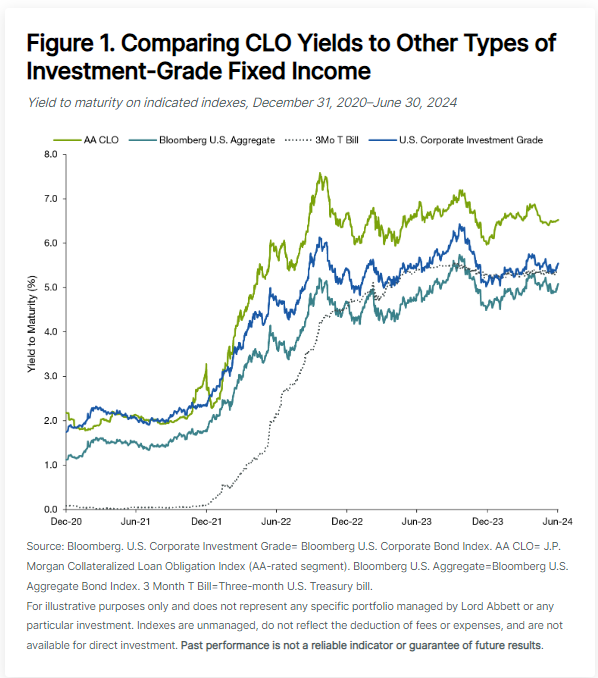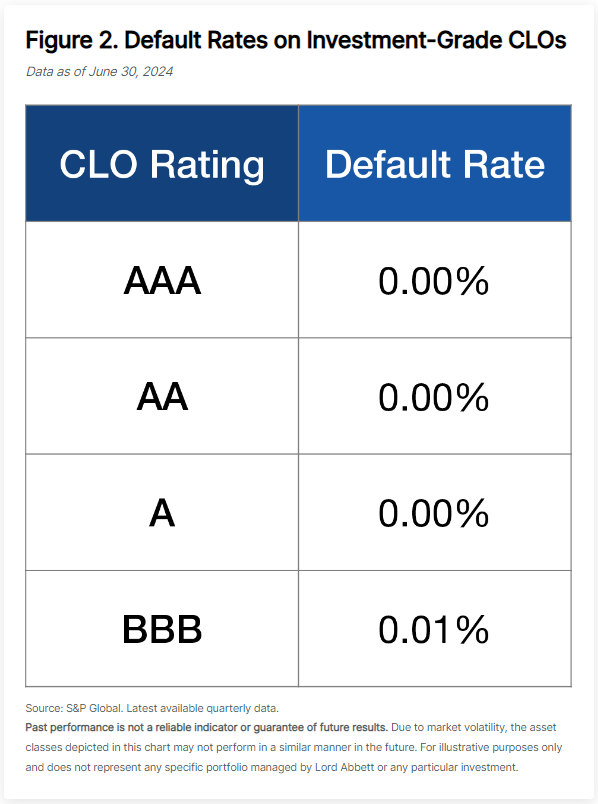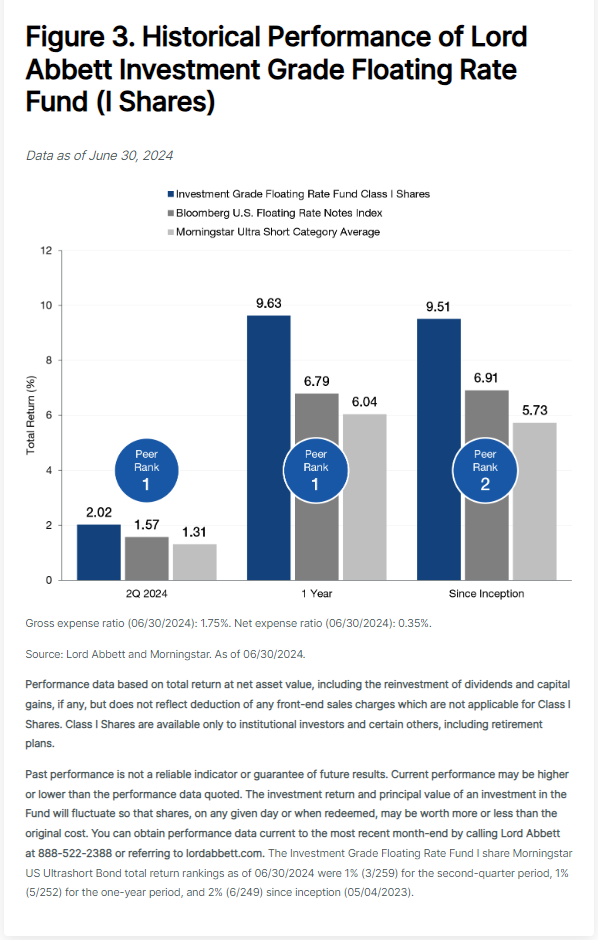Link para o artigo original: https://www.lordabbett.com/en-us/financial-advisor/insights/investment-objectives/investment-brief–addressing-key-questions-on-clos.html
Insight • September 20, 2024 6 min. Read
Investment Brief: Addressing Key Questions on CLOs
As investor interest in collateralized loan obligations grows, we examine the important characteristics of the asset class—and its relevance for investors.
![]() By Joseph M. Graham,
By Joseph M. Graham, ![]() Alex Mink
Alex Mink
Over the last year, collateralized loan obligations (CLOs) have garnered increased attention from investors. With attractive spreads and historically low defaults compared to other areas of fixed income, we believe the asset class deserves attention. We have been investing in CLOs for over a decade across our fixed income strategies.
But while CLOs are achieving wider recognition, the asset class remains unfamiliar to many investors. Here, we offer an overview of CLOs and address some of the most common questions we receive.
What are CLOs?
At a high level, CLOs are structured financial products backed by a pool of loans, typically leveraged corporate loans. These loans are packaged together and sold to investors in different tranches, each representing varying levels of risk and return. The cash flows from the underlying loans are distributed to investors based on the seniority of the tranche they hold—senior tranches receive payment first and have lower risk, while junior or equity tranches bear more risk but offer higher potential returns.
This process of pooling and structuring risk has historically allowed a CLO manager to issue debt, on average among all the tranches, more cheaply than the rates on the loans it is buying, enabling the manager to profit from the spread over time.
Why would investors want CLO debt?
The investors in CLO debt receive high quality, diversified, floating rate loan exposure; CLO debt typically offers better spreads than corporate bonds of the same rating, and historically fewer defaults, based on data from S&P Global.
We strongly advocate for diversifying fixed income exposure in investment portfolios, including CLOs along with other asset classes, to balance risk and earn the additional carry available in corporate bonds, loans, and securitized products. We think CLOs are particularly effective for balancing fixed income portfolios because both the credit orientation and the floating rate feature help diversify the rate exposure that is often the most dominant risk in most fixed income portfolios.
In addition, the substantial yield advantages, as shown in Figure 1, can help provide protection against credit and interest rate volatility.

What’s driving the opportunity in CLOs?
Traditionally, this spread has been compensation for less liquidity rather than actual default experience, which has been near zero for investment-grade CLOs, based on S&P Global data. The primary buyers of CLOs were banks and insurance companies taking advantage of a capital cost arbitrage on the rating, but they tended to buy and sell at the same time, leaving the market volatile and without liquidity in times of stress.
In the last few years, though, a wider array of buyers, including retail investors through exchange-traded funds (ETFs), has come to the market seeking protection from rising rates. The benefit for the CLO market has been greater investor awareness, more trading, and increased liquidity. Data from Trace cited in a recent Top Chart report show that weekly trading volume in CLOs roughly quadrupled from the end of 2014 through June 30, 2024.
In addition, CLOs have had a greater opportunity set since the global financial crisis (GFC) of 2008–09, as banks curtailed lending in response to balance sheet regulation imposed by the 2010 enactment of the Dodd-Frank Act. The appetite for leverage among corporate issuers remains and CLOs have supported the syndicated bank loan market to fill that need.
What is the default experience of investment-grade CLOs?
CLOs do have principal risk, because they are sensitive to defaults in the loan pool, and liquidity and market risks due to fluctuations in credit spreads and market conditions.
The collateralization and prioritization of the debt tranches leads to a wide stratification of probabilities of principal loss and consequent yields over those tranches. An AAA-rated tranche of CLO debt will have around 40% in subordinate tranches, meaning that the loans bought by the CLO would have to generate 40% in principal losses before generating losses for the AAA tranche. Given historical recoveries in the 40% range for bank loans, this would mean over 65% of loans would need to default over the life of the CLO for that to happen. Trailing 12-month default rates for bank loans sit at 3.1% as of June 30, 2024, according to S&P Global; looking at recent history, defaults peaked at levels around 12% before quickly falling in each of 2009, 2002, and 1990, nowhere near levels that would cause loses for the AAA tranche.
While reinvestment periods and triggers that direct capital flows make the math not quite that simple in practice, the general safety of the AAA tranche (and even the AA- and A-rated tranches) is something that has not been tested throughout the GFC, the COVID-19 pandemic, and other market shocks, as shown in Figure 2.

What is the CLO “feedback loop,” and how might it benefit the market?
One of the things that separates CLOs from less well-conceived structures, in our view, is what can be considered a self-regulating ecosystem of issuance. The capital requirements for forming a CLO are relatively high, and the risks to equity are substantial, requiring a mid to high teens percentage equity return to compensate for those factors. If underwriting standards loosen or defaults increase, a quick feedback loop ensures the cost of debt rises for the sponsor, making the structure uneconomical for the equity investors in the CLO, or, alternatively, the sponsor is forced to tighten underwriting standards.
It’s that tight feedback loop that leads to a stable market structure, in our view, something much different than, for example, subprime mortgages before the GFC. In that market, lending standards loosened for decades, drawing on conventional wisdom that home prices would continue to appreciate, and enabled by offloading of risk to third parties, which kept the market unchecked until a small slowdown created a large problem.
What about the potential for negative convexity?
The CLO manager’s ability to refinance a CLO can lead to negative convexity in times of falling rates, as this refinancing option shortens the life of the security and caps the value near par, a condition that explains some of the increased spread when compared to instruments with a similar credit rating but more call protection.
We believe interest rates are entering a period of more certainty as the variance in U.S. inflation data begins to narrow from month to month. This means the option of refinancing (the option an owner of a CLO tranche is short) is worth less and the refinancing risk is less, making the high carry featured by CLO debt more attractive.
Why consider an active approach to CLO investing?
Over the last few years, there have been several investment products created to focus on investment-grade floating rate assets, including CLOs. We believe a flexible and diversified approach to investing in investment-grade floating rate instruments can have an advantage over a single asset class or rules-based structure, especially as market environments change and the opportunity set evolves.
At Lord Abbett, we have a deep and experienced team of investment professionals who have been investing in corporate and securitized credit for decades. The Lord Abbett Investment Grade Floating Rate Fund was launched in 2023 to provide clients with access to high quality floating rate investments, with a concentration in CLOs but the flexibility to find relative value in syndicated loans, ABS, CMBS, RMBS, and floating rate corporate bonds. Since that time we have proven our ability to use an active approach to best the floating rate index and peers in the category, as shown in Figure 3.

About the Contributors
Joseph M. Graham, CFA
Senior Managing Director, Head of Investment Strategist Group
Alex Mink, CFA
Product Specialist
Essas informações podem conter declarações de previsões que envolvem riscos e incertezas; os resultados reais podem diferir materialmente de quaisquer expectativas, projeções ou previsões feitas ou inferidas em tais declarações de previsões. Portanto, os destinatários são advertidos a não depositar confiança indevida nessas declarações de previsões. As projeções e/ou valores futuros de investimentos não realizados dependerão, entre outros fatores, dos resultados operacionais futuros, do valor dos ativos e das condições de mercado no momento da alienação, restrições legais e contratuais à transferência que possam limitar a liquidez, quaisquer custos de transação e prazos e forma de venda, que podem diferir das premissas e circunstâncias em que se baseiam as perspectivas atuais, e muitas das quais são difíceis de prever. O desempenho passado não é indicativo de resultados futuros.

